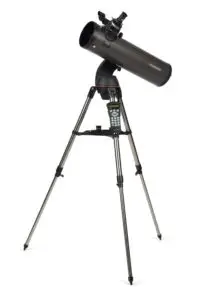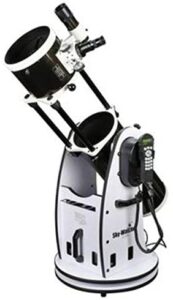Computerized or “Go To” telescopes are advanced telescopes matched with a GPS and PC framework that enables you to follow stars and planets without the need for an astronomy map. With such a modernized telescope, you won’t have to experience the agony of manually finding celestial bodies. The best goto telescopes include models from popular brands, including Celestron, Meade Instruments, and Sky-Watcher. Let’s explore.
1. Celestron NexStar 130SLT – Best low-cost goto telescope

Celestron NexStar 130SLT is a ridiculously affordable yet high-tech telescope. It comes with a 130mm aperture that gives you grand vistas of the starry heavens.
The focal ratio is fast at f/5, and you also get to benefit from a 2″ focuser. With this, you can use two eyepieces that expand the field of view up to almost 4 degrees.
The first eyepiece is about 25mm and fitted with a lunar channel to gaze at the cosmic systems. The second eyepiece, which is 9mm, is incredible for investigating the planets.
The eyepieces are all sturdy and can serve you for ages.
Check PriceFeatures
• Aperture: 130 mm
• Focal length and ratio: 650 mm (f/5)
• Eyepiece: Plossl 25 mm
• Weight: 18 lbs
2. Meade Instruments ETX125 – Best in user-friendliness

The improved lighting ability and this model’s movability make it an ideal fit for novice and expert stargazers alike. Dissimilar to the numerous models of mechanized telescopes, the Meade Instruments ETX125 is anything but difficult to set up and use.
A wide aperture of 127 mmm reveals many secrets of the night sky. The focal length and ratio are 900mm f/15, while an internal mirror function allows for dual viewing.
The Meade Instruments ETX125 was produced using superior quality aluminum and first-grade plastic for many years.
Check PriceFeatures
• Aperture: 127 mm
• Focal length and ratio: 1900 mm (f/15)
• Weight: 25 lbs
• Eyepiece: Plossl (9.7 mm, 26 mm)
3. Sky-Watcher GoTo Collapsible 8″ Dobsonian – Best for largest views

Unlike stand-mounted goto telescopes, this Goto Dobsonian can generally be pushed physically without interfering with its alignment. This helps to save more power in focusing and fine-tuning the view.
203 mm of the aperture is sufficient to witness all the fascinating things that could be missed by a smaller instrument—thousands of galaxies and planetary nebulae.
The scope comes with two Plossl eye-pieces: A 25mm (48x) and 10mm (120x), which perform nicely with the device f/6 focal ratio.
Check PriceFeatures
• Aperture: 203 mm
• Focal length and ratio: 1200 mm (f/6)
• Eyepiece: Plossl (25mm, 10 mm)
• Weight: 55 lbs
How to Choose the Best Goto Telescope
If you are just getting started, you can get a reflector or refractor telescope. For buyers who need low maintenance devices, a refractor telescope is an excellent decision to consider.
Refractor and compound telescopes are great for watching birds and distant objects. For watching stars and planets in the night sky, reflector, and compound telescopes come in handy.
A bigger aperture is better.
When looking for the best goto telescope, the primary feature of consideration should be the aperture. A telescope with a big aperture, such as the 203 mm on the Sky-Watcher GoTo Collapsible 8″ Dobsonian, allows more light to flood into the eyepiece. With more light, you’ll get an improved picture quality and be able to see the smallest and furthest objects in the night sky.
The Focal Length must be big too.
Another essential element is the focal length, and it acts as the distance from the goto telescope’s focal position to the lens. With a big focal length, smaller objects appear more magnified. In this regard, you will have a better experience watching the stars on the Meade Instruments ETX125 than the Celestron NexStar 130SLT.
It would be helpful to find telescopes that have a big length of the focal and aperture. But in case you are on a shoestring budget and must select between the two features, prioritize the aperture.
Consider magnification of the scope.
All telescopes have functions for magnifying the night sky objects, and the length of the focal and eyepiece dictate the degree of enlargement that you’ll have.
Magnification is the main thing that comes to mind for many telescope buyers, and for that reason, many less expensive telescopes stress magnification over other things. However, if the instrument is not built to deliver a clearer picture, a large magnification will be for the birds.
Seamless electronic controls
In the relatively recent past, all telescopes required manual operations. There was no automatic way to focus them on specific heavenly bodies of stars. That has since changed, as is evidenced by the programmable nature of goto telescopes.
Today, the best goto telescopes allow you to seamlessly focus on the objects you want to view by the touch of a button. They feature a pre-programmed chip and a database of coordinates for a better user experience. The SkyWatcher S11800 GoTo Collapsible Dobsonian 8-Inch features a pre-programmed database of 42000 objects—this can keep you busy for thousands of nights.
Choose the best mount.
A telescope accessory that is always ignored is the mount, and each telescope needs strong support to function. Numerous advanced telescopes are sold as complete structures and accompany amount, but you should consider getting a better mount to get the most from the device.
Some users may just buy an optics tube and mount it to a standard camera stand. This sounds like a quick fix to the problem, but consider that most camera tripods are sturdy enough for a telescope.
The best mounts should allow you to swing your telescope toward any path, and whenever you’ve locked onto the objective item, the support should hold the optics tube utterly still.
If your budget allows, think about purchasing a mechanized mount. A mount with a motor is additionally easy to be controlled from a computer. This takes the stress out of focusing, so you can spend more time viewing than searching.
Buying a goto telescope is a big decision, and if you choose the best item, it can transform how you perceive the universe. The Sky-Watcher GoTo Collapsible 8″ Dobsonian with its magnificent aperture of 203 mm stands out from both the Celestron NexStar 130SLT and the Meade Instruments ETX125 as the best goto telescope for profound night sky investigation, exploration, and study.
Other Questions You Might Have
What are the key features to consider when choosing the best computerized telescope for stargazing enthusiasts?
When selecting the best computerized telescope for your stargazing pursuits, it’s essential to prioritize features like aperture size, mount type, and included software. A larger aperture, such as 8 inches or more, will allow you to observe fainter objects. Equally important is the mount type – go for an altazimuth or equatorial mount for precise tracking. Look for telescopes that come with user-friendly software like GoTo systems, which enable automated celestial object location.
How do computerized telescopes with GoTo functionality simplify the stargazing experience for beginners?
Computerized telescopes with GoTo (Go To) functionality are a game-changer for beginners. These telescopes are equipped with databases containing thousands of celestial objects. By selecting an object from the menu, the telescope automatically slews to that target, making locating objects hassle-free. This simplifies the learning curve, enabling beginners to enjoy the wonders of the night sky without extensive prior knowledge.
Are there any recommended computerized telescopes specifically designed for astrophotography enthusiasts?
Absolutely! For astrophotography, consider computerized telescopes with features like sturdy equatorial mounts, accurate tracking, and compatibility with DSLRs or dedicated astronomy cameras. Models like the Celestron NexStar Evolution series and the Meade LX200ACF series offer both impressive visual observing and solid astrophotography capabilities, with the necessary precision for capturing stunning celestial images.
What advantages do computerized telescopes offer over traditional manually operated telescopes?
Computerized telescopes bring automation and convenience to stargazing. Unlike traditional telescopes that require manual adjustments to locate celestial objects, computerized telescopes use motorized mounts and databases to find objects with precision. This eliminates frustration, reduces setup time, and allows you to spend more time enjoying the celestial wonders rather than searching for them.
Can I control computerized telescopes using my smartphone or tablet?
Yes, many modern computerized telescopes offer smartphone or tablet compatibility. Manufacturers often provide dedicated apps that allow you to control the telescope, align it accurately, and choose celestial objects to observe or photograph. This wireless control adds another layer of convenience, enabling you to operate the telescope remotely from your smart device.
What are some reputable brands known for producing the best computerized telescopes?
Several reputable brands are synonymous with quality computerized telescopes. Celestron and Meade are top contenders, renowned for their innovative designs, reliable optics, and advanced GoTo systems. Additionally, brands like Orion and Sky-Watcher offer a range of computerized telescopes tailored to different skill levels and preferences, ensuring there’s a suitable option for every stargazing enthusiast.
Are computerized telescopes suitable for educational purposes in schools and astronomy clubs?
Absolutely! Computerized telescopes are fantastic educational tools. Their automated features simplify the process of finding celestial objects, making them ideal for introducing students or astronomy club members to the night sky. The interactive nature of computerized telescopes enhances engagement and helps learners grasp complex astronomical concepts more effectively.
What are some entry-level computerized telescopes that provide excellent value for beginners?
For beginners, entry-level computerized telescopes like the Celestron NexStar 130SLT and the Orion StarSeeker IV series offer excellent value. These models typically come with manageable apertures, user-friendly GoTo systems, and comprehensive databases. They strike a balance between affordability and performance, making them a great starting point for aspiring astronomers.
How important is the accuracy of tracking in computerized telescopes for observing planets and deep-sky objects?
Tracking accuracy is paramount, especially when observing planets and deep-sky objects. Precise tracking ensures that the telescope counteracts Earth’s rotation, keeping objects within the field of view for extended periods. High-quality computerized telescopes utilize advanced tracking systems, such as auto-guiders and periodic error correction, guaranteeing crisp and detailed views whether you’re studying distant galaxies or the intricate features of Jupiter.
Can I upgrade the components of my computerized telescope, such as the mount or optics, as I advance in my astronomy journey?
Yes, upgrading components of your computerized telescope is often possible. Many telescopes offer modular designs, allowing you to replace or enhance parts like mounts, eyepieces, and even optics. However, ensure compatibility and consider seeking expert advice before making significant upgrades. This flexibility lets you tailor your telescope to match your evolving skill level and preferences as you progress in your astronomy journey.




